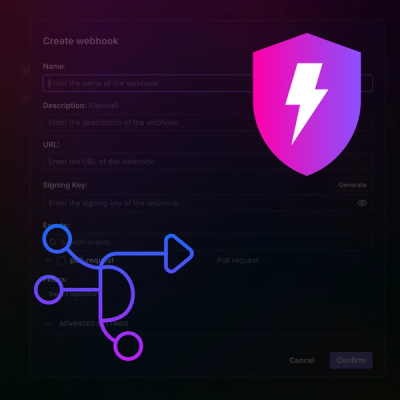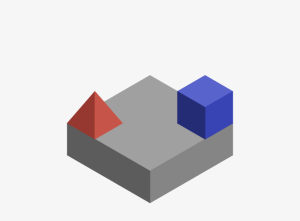
Product
Introducing Webhook Events for Pull Request Scans
Add real-time Socket webhook events to your workflows to automatically receive pull request scan results and security alerts in real time.

An isometric graphics library for HTML5 canvas.
View the official project page or try it out.
Isomer is an easy-to-use graphics library for drawing isometric scenes.
var Shape = Isomer.Shape;
var Point = Isomer.Point;
var Color = Isomer.Color;
var red = new Color(160, 60, 50);
var blue = new Color(50, 60, 160);
iso.add(Shape.Prism(Point.ORIGIN, 3, 3, 1));
iso.add(Shape.Pyramid(Point(0, 2, 1)), red);
iso.add(Shape.Prism(Point(2, 0, 1)), blue);

First, grab a copy of Isomer here. You can also pay for it. Then, include the script wherever you see fit:
<script src="/path/to/isomer.min.js"></script>
After which you'll need to place a canvas in your document that we can later refer to. Be sure to give it a width and height.
<canvas width="800" height="600" id="art"></canvas>
Note (Optional): To improve the look of your canvas on retina displays, declare the width and height of your canvas element as double how you want it to appear. Then style your canvas with CSS to include the original dimensions.
#art {
width: 400px;
height: 300px;
}
At this point we can finally instantiate an Isomer object. Pass it a reference to your canvas like so:
var iso = new Isomer(document.getElementById("art"));
Now you're ready to start drawing!
Isomer uses Gulp as a build tool. To build the project, first install the dependencies.
$ npm install
Then run npm run dist:
$ npm run dist # or, alternatively, `gulp dist`
> isomer@0.2.5 dist /Users/jordan/Projects/isomer
> gulp
[gulp] Using gulpfile ~/Projects/isomer/gulpfile.js
[gulp] Starting 'dist'...
[gulp] Version: webpack 1.7.3
Asset Size Chunks Chunk Names
./dist/isomer.js 23.1 kB 0 [emitted] isomer
[gulp] Version: webpack 1.7.3
Asset Size Chunks Chunk Names
./dist/isomer.min.js 9.33 kB 0 [emitted] isomer
[gulp] Finished 'dist' after 911 ms
[gulp] Starting 'default'...
[gulp] Finished 'default' after 6.2 μs
To generate isomer.js and isomer.min.js in the dist/ directory.
Isomer is developed using Webpack. Install dependencies and build the project like so:
$ npm install
$ npm run dist
test/index.html contains a basic testing page that draws various shapes. This page will load a unminified bundle with source maps.
The test script (accessible via npm test) uses webpack-dev-server to automatically rebuild Isomer on any file changes. This script also opens the testing page (located at http://localhost:2992/webpack-dev-server/) in your default browser. The testing page includes a live reload script to refresh when Isomer is rebuilt and notify if the code is not conform the styling conventions for Isomer.
$ npm test
> isomer@0.2.5 test /Users/jordan/Projects/isomer
> gulp test
[Isomer] listening on http://localhost:2992/
webpack: wait until bundle finished: /webpack-dev-server/
Hash: ************
Version: webpack 1.8.2
Time: 432ms
Asset Size Chunks Chunk Names
isomer.js 59.5 kB 0 [emitted] isomer
chunk {0} isomer.js (isomer) 20.1 kB [rendered]
[0] ./index.js 83 bytes {0} [built]
[1] ./js/isomer.js 3.86 kB {0} [built]
[2] ./js/canvas.js 729 bytes {0} [built]
[3] ./js/color.js 2.68 kB {0} [built]
[4] ./js/path.js 3.77 kB {0} [built]
[5] ./js/point.js 2.44 kB {0} [built]
[6] ./js/shape.js 5.47 kB {0} [built]
[7] ./js/vector.js 1.05 kB {0} [built]
webpack: bundle is now VALID.
Isomer also accepts the canvas provided by node-canvas, meaning you can generate isometric graphics on the command line.
var Canvas = require('canvas');
var canvas = new Canvas(400, 400);
var Isomer = require('isomer'); // npm install isomer
var fs = require('fs');
var out = fs.createWriteStream('output.png');
var iso = new Isomer(canvas);
iso.add(Isomer.Shape.Prism(Isomer.Point.ORIGIN));
canvas.pngStream().pipe(out);
For more info, check out the official project page.
FAQs
A simple isometric graphics library for HTML5 canvas
We found that isomer demonstrated a not healthy version release cadence and project activity because the last version was released a year ago. It has 1 open source maintainer collaborating on the project.
Did you know?

Socket for GitHub automatically highlights issues in each pull request and monitors the health of all your open source dependencies. Discover the contents of your packages and block harmful activity before you install or update your dependencies.

Product
Add real-time Socket webhook events to your workflows to automatically receive pull request scan results and security alerts in real time.

Research
The Socket Threat Research Team uncovered malicious NuGet packages typosquatting the popular Nethereum project to steal wallet keys.

Product
A single platform for static analysis, secrets detection, container scanning, and CVE checks—built on trusted open source tools, ready to run out of the box.